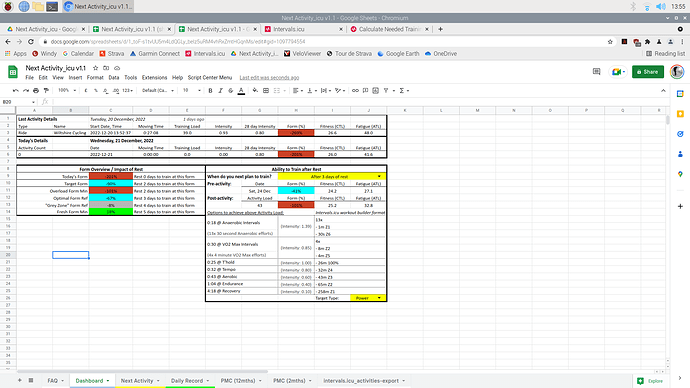Hi Jason,
I feel like I’ve posted this before, but maybe not on this thread.
I’m using the usual exponential decay formulae with the normal 42 and 7 day figures, which gives me that new Load contributes 0.023528*Load to Fitness and 0.133122*Load to Fatigue and Fitness decays to 0.976472*Fitness and Fatigue decays to 0.866878*Fatigue overnight.
If you’re going to do some LOAD today, and you want to know how much to do to keep yourself at Form = -10:
Fitness(new) = Fitness(old) + LOAD*0.023528
Fatigue(new)= Fatigue(old) + LOAD*0.133122
You want Fitness(new) - Fatigue(new) = -10. So, substituting:
Fitness(old) + LOAD*0.023528 - Fatigue(old) - LOAD*0.133122 = -10
Rearranging, you get:
LOAD = (10 + Fitness(old) - Fatigue(old))/(0.133122 - 0.023528), or
LOAD = (10 + Fitness(old) - Fatigue(old))/0.109594 [Formula 1]
Similarly, for Form = -30, the formula is:
LOAD = (30 + Fitness(old) - Fatigue(old))/0.109594 [Formula 2]
You didn’t ask for this but, if you’ve finished for the day but you’re going to do some LOAD tomorrow, you need to take account of the decay overnight:
Fitness(new) = Fitness(old)*0.976472 + LOAD*0.023528
Fatigue(new) = Fatigue(old)*0.866878 + LOAD*0.133122
You want Fitness(new) - Fatigue(new) = -10. So, substituting:
Fitness(old)*0.976472 + LOAD*0.023528 - Fatigue(old)*0.866878 - LOAD*0.133122 = -10
Rearranging, you get:
LOAD = (10 + Fitness(old)*0.976472 - Fatigue(old)*0.866878)/(0.133122 - 0.023528), or
LOAD = (10 + Fitness(old)*0.976472 - Fatigue(old)*0.866878)/0.109594 [Formula 3]
Similarly, for Form of -30, the formula is:
LOAD = (30 + Fitness(old)*0.976472 - Fatigue(old)*0.866878)/0.109594 [Formula 4]
So these four formulae are what you need (apart from stopping them going negative).
So, for example, if you look at your current Fitness and Fatigue values, plug them into Formula 3 and plan an activity for tomorrow with the Load it proposes, you should see your form curve hitting -10. It might not be spot-on because intervals only displays rounded figures for Fitness and Fatigue.
You really want intervals to display these for you, and custom activity fields might let you do it, but you really have to have done an activity - you can’t display them at the Fitness level (at the moment).
Hope that helps.


